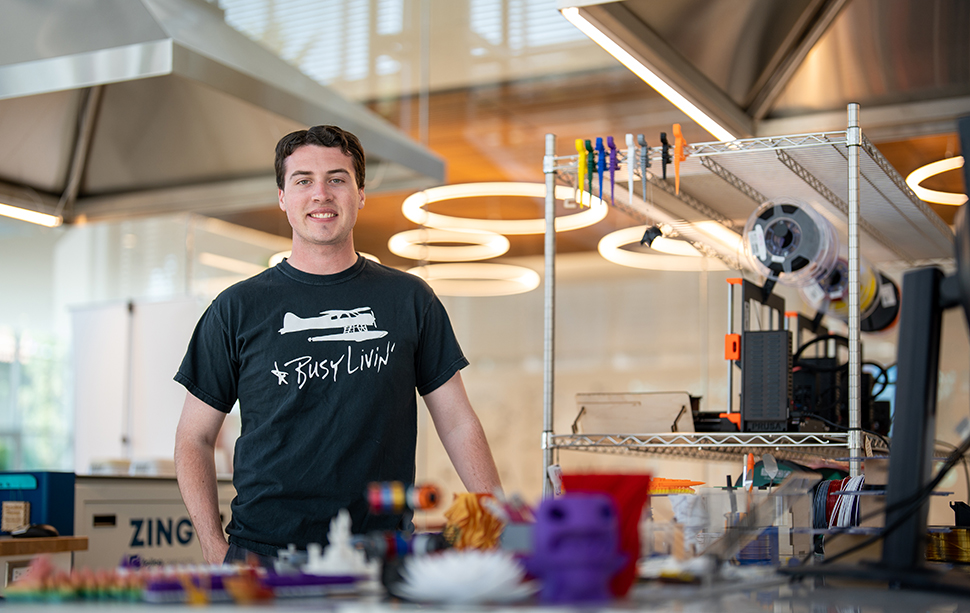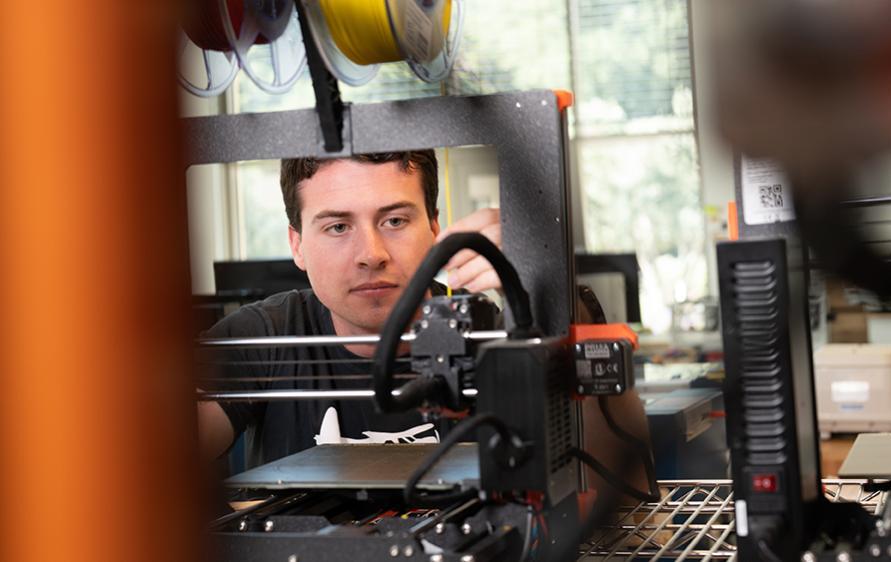Taking Flight

Growing up on San Juan Island in Washington state gave Julian Brown ’23 an appreciation for how big the world can feel. Even though his one-stoplight town was just 100 miles from Seattle as the crow flies, its island location made everyday activities an all-day affair.
“If you wanted anything more than basic necessities, it was an hour-long ferry ride,” Brown says. “To get to Seattle, it was a ferry ride, plus at least a two-hour drive.”
Most of the time, Brown opted to stay at home and work around the house, rebuilding his first Honda motorcycle at age 10, an old BMW by 16, and then transforming a VW Bug into a dune buggy. As he got older, his interest turned to the skies.
Floatplanes are popular in the Pacific Northwest and especially so on San Juan Island. The small passenger planes give residents the freedom to avoid the trappings of the archipelago and go where they want more quickly.
“I’d watch them fly in front of my house every day and think, ‘Well, how long does it take for that to get to Seattle?’” Brown says. “The answer was about 45 minutes. For someone who grew up in a small town to get to a major metropolitan area in 45 minutes—because of this higher level technology—was fascinating.”
In high school, Brown was in the Aerospace Club and competed in an International Space Settlement Design Competition where he traveled to Cape Canaveral, Fla. On display in the Kennedy Space Center was the Space Shuttle Atlantis up close and, unlike the immaculately polished shuttles he’d seen in books, it showed the wear of space with burn marks streaked up the front.
“It looked like it was in action, tearing through the atmosphere,” Brown remembers. “I don't think any of us can properly conceptualize 17,000 miles an hour and what kind of engineering goes into that. Ever since then I've known this is what I want to do, this is what I'm cut out for.”
Earlier this year, Brown got one step closer to his dream. He accepted a position with Lockheed Martin in Sunnyvale where he will start a career working in aerospace engineering as an opto mechanical engineer after graduation. He sat down to talk with us about his time at SCU and what comes next.
You knew you wanted to be an engineer early on in life. What lessons did you learn from fixing up cars and motorcycles growing up?
It was really about problem-solving. We didn't have a manual. We were working in a garage, we had some tools and a welder. My friend’s dad knew a bit about cars and he’d tell us if we were on the right track. But it was two steps forward, one step back because you think you’re taking the right approach and it still might not work. It taught me that problems are almost always more complex than they are in a book. It was a good raw example of why you have to synthesize knowledge to solve a problem.
How has this problem-solving mentality served you in college?
For me, it’s taught me that my grade is not as important as what I learn. In engineering, you have this discrete and implicit connection with humans in society. You need to be honest with yourself about your skills and audit your knowledge so you don’t put other people in danger.

That’s why I ask so many questions. Sometimes people don't want to ask questions because they think they might sound stupid. I don’t mind asking those questions. I’ve had a growth mindset since I was about 15 and I'm a big believer that you learn more from failures than successes. I want to fail frequently and fail often, especially in my twenties, to see how much I can learn.
What was one of your failures at Santa Clara?
Freshman year I took a math class and, like everyone else in the class, I bombed the midterm. Some people gave up and either dropped the class or accepted that they were going to get a C. My thought was, well, sure, I might get a B or C, and that's fine. But I'm going to live in office hours and ask a lot of questions and become a master of the subject. For me, that worked and I ended up getting a good grade.
You’ve been pretty involved at Santa Clara, from tutoring students for Tau Beta Pi to working on GPS control strategies for the agricultural robots in the Robotic Systems Lab. What was the most meaningful experience for you at Santa Clara?
I’d actually say it’s the time I spent with professors. I'm someone who is interested in everything. I've never taken an engineering class that I didn’t think would serve me in my career. After the pandemic, getting to connect with professors was really meaningful and that’s something that doesn't happen at bigger schools. At Santa Clara, if you showed you cared about the subject and wanted to learn, professors could tell and they fed off that.
You are a Catala Club scholar, which has paid for almost all of your tuition. What has that experience been like?
This scholarship was one of the main reasons I came to Santa Clara. Last year, I got to meet members of the Catala Club and they were super great people. I have been able to stay in touch with them and just met with one of the members two weeks ago. I am very grateful for the scholarship and I wouldn't be here without them.
Tell me about your job at Lockheed Martin
Working for Lockheed has always been a dream. When you think of government R&D, you think of SR-71s, you think of Skunk Works. These are the poster children of American aerospace engineering in the last century. There are so many problems in space travel that are not only super interesting but are problems that, when solved, are going to change the course of human history. I just really wanted to be a part of that.